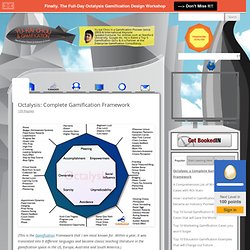

Gamification. Some Differences Between Experts and Novices. Harrisburg Presentation Resources Here are some resources from my presentation in Harrisburg.

Three Thoughts on #Games & #Gamification. Harrisburg Presentation Resources Here are some resources from my presentation in Harrisburg.

Defining and Exploring Gamification from Karl Kapp Here is some additional information. Articles and Blog Entries of Interest 8 Types of Stories to Effect Change Storytelling and Instructional Design Eight Game Elements to Make Learning More Intriguing Games, Gamification and the Quest for Learner Engagement Gamification, […] Continue Reading → 2014 DOE Symposium Conference Resources Here are my resources for the 2014 DOE Symposium Conference. Continue Reading → Galactic Arms Race (GAR) 5 Predictions for Game Mechanics in 2011. Gabe Zichermann is the author of the critically acclaimed book Game-Based Marketing (Wiley, 2010), the upcoming Gamification by Design (O’Reilly, 2011) and blogs at Gamification.co.

He’s also the chair of the January Gamification Summit in San Francisco. Mashable Readers are invited to attend with a special discount by using the code GSMASH11 at GSummit.com. This year was the first time most people heard the term "Gamification," the process of using game thinking and game mechanics to solve problems and engage audiences. Although this strategy has always been around us, a combination of factors have made the topic explode onto the scene. Game Mechanics. In this past Sunday’s Wall St.

Journal, Farhad Manjoo had a piece on gamification in the workplace. It begins… Envision that every one of your professional endeavors was meticulously tracked and measured in points, that there were levels to complete and you were given prizes for excellence. That every workplace action provided a tangible sensation of winning or losing as part of a system engineered to keep you addicted, thrilled to come back every morning. I attempted to do just that back in 2012. PSFK Future of Gaming Report. The twenty-first century will be gamified, or it will not. GM4C. Game Mechanics. Harvard Researchers Find A Creative Way To Make Incentives Work. Incentives are all the rage: employee bonus pay, app badges, student grades, and even lunch with President Obama.

Despite their widespread use, most research finds that incentives are terrible at improving performance in the long-run on anything but mindless rote tasks, because the fixation on prizes clouds our creative thinking (video explanation below). However, a new Harvard study of teachers found that a novel approach to incentives could dramatically improve student performance: give teachers a reward upfront and threaten to take it away if performance doesn’t actually improve. Exploiting the so-called “loss-aversion” tendency could open the door to creative incentivizing for software designers and managers. Harvard University’s Ronald Fryer and his colleagues explain that, in education, pay-for-performance has a dismal record of improving student outcomes. However, humans process loss differently gain. The research holds exciting possibilities for business. Game mechanics. Game mechanics are constructs of rules intended to produce a game or gameplay.

All games use mechanics; however, theories and styles differ as to their ultimate importance to the game. In general, the process and study of game design, or ludology, are efforts to come up with game mechanics that allow for people playing a game to have an engaging, but not necessarily fun, experience. Game mechanics vs. gameplay[edit] Gameplay refers to the overall game experience or essence of the game itself. There is some confusion as to the difference between game mechanics and gameplay. For example, the basic gameplay of a shooting or fighting game is to hit while not being hit. What is Gamification. If you want to make Gamification actionable, Check out my Complete Gamification Framework called Octalysis and Video Lecturer Series.

For those who been following my blog regularly, its pretty apparent that I have been writing heavily into the topic of Gamification. This may be an unfamiliar word for many of you. What is Gamification? This post is a quick overview to explain what is Gamification about and clear up a great deal of misconceptions in the industry. Octalysis: Complete Gamification Framework. (This is the Gamification Framework that I am most known for.

Within a year, it was translated into 9 different languages and became classic teaching literature in the gamification space in the US, Europe, Australia and South America.) Octalysis: Complete Gamification Framework Gamification is design that places the most emphasis on human motivation in the process. In essence, it is Human-Focused Design (as opposed to “function-focused design”). Most processes design around function and efficiency – they try to get the job done as quickly as possible. The ten rules of gamification. Gamification may have been the buzzword of 2010, but its influence shows no sign of abating in 2011.

It is a term derided by game designers, misunderstood by brands and unknown to consumers. So as you set out to “gamify” your business, what are the cardinal rules of gamification? 1. Gamify your business - game-mechanics and game-dynamics. Gamification Study. 7 Winning Examples of Game Mechanics in Action. Gabe Zichermann is the author of Gamification by Design and chair of the upcoming Gamification Summit NYC, where top leaders in the field - such as those profiled here - get together to share insight, key metrics and best practices.

Mashable readers are invited to register with special savings at GSummit.com using code MASH10. Octalysis: an Actionable Gamification Framework from an Industry Pioneer. In the past 9 years that I have been working in Gamification (I remember the old awkward days of telling people “I specialize in making your products game-like” only to hear back, “Why would our customers want to play games?”) , I’ve seen many attempts of Gamification that only turn out to be gimmicky, unsustainable, and simply adding no value nor ROI to products. As Gamification is becoming the hot buzzword these days, more and more agencies are slapping on the word “Gamification” as one of their expertise, even though many of them have never truly dived deep into a game before. Just like “creating a Twitter profile and a Facebook Page” was what many did for Social Media Marketing a few years back, right now company’s are throwing PBLs – points, badges, and leaderboards – everywhere without remembering that most games have PBLs in them too, but only a small selection of games are actually fun.
Games are not fun because they have PBLs. They’re fun because they appeal to our Core Drives.
How to Use Game Mechanics to Reward Your Customers. There's a green card. Then there's silver, gold, and platinum. And then there's the Centurion—the black American Express card. Gamification main mechanisms. Best Practices: Applying The Seven Deadly Sins To Successful Gamification. Published on February 23, 2011 by R "Ray" Wang The Seven Deadly Sins Draws On The Dark Arts Conversations with game designers and gamification experts over the past month highlight how important design should appeal to the human spirit.
Intrigue, reward, status, community, and challenge drive 5 key areas of engagement. However, some of the masters of gamfication have revealed some dark arts that touch on connecting with human psychology to engage (see Figure 1). One approach is applying the seven deadly sins. Figure 1. Lust appeals to lack of self control and attraction. The Power of Virtual Gifts in a Gamified World « Strategic Synergy. Question: If you had the choice between a real rose and a virtual rose, which would you choose? Before answering, let’s take that virtual rose, and present it in some context. Perhaps the virtual gift is an invitation, hinting at fun and social entertainment with friends. Now make that virtual rose persistent, so the flower is available at every visit to your site.
Display the rose in a public environment, where others see the gift from a friend. And lastly, add functionality to the rose, perhaps the rose completes a collection, unlocks new content, or provides new status within the community. Virtual Gifts are experiences that can be used as positive and powerful social exchanges. Welcome to Flow in Games. Abstract | Introduction | Foundation | Design Flow in Games | Implement Flow in Games | Conclusion | Bibliography Abstract. Gameful. Main Page - Gameful. GAMEFUL, a Secret HQ for Worldchanging Game Developers by Jane McGonigal.
Game Development. List of game engines. Many tools called game engines are available for game designers to code a game quickly and easily without building from the ground up. Free/libre and open source software[edit] Note: The following list is not exhaustive. It mixes game engines with rendering engines as well as API bindings without any distinctions. Proprietary[edit] Commercial[edit] Freeware[edit] These engines are available without monetary charge, but without the source code being available under an open-source license. With related games[edit] Game Development Tools & Game Engines. SCVNGR's Secret Game Mechanics Playdeck. Some companies keep a playbook of product tips, tricks and trade secrets. Zynga has an internal playbook, for instance, that is a collection of “concepts, techniques, know-how and best practices for developing successful and distinctive social games”.
Zynga’s playbook has entered the realm of legend and was even the subject of a lawsuit. 101 Game Design Principles for Social Media. Core Concepts of Gamification. Outstanding presentation from Amy Jo Kim, an adjunct professor of Game Design at USC’s Digital Media school, recently named top US-based game design school. She’s also the author of Community Building on the Web (2000), a design handbook for digital communities that’s used worldwide at game studios & universities. [Email Amy]. This presentation was delivered at Casual Connect Seattle, July 2011.
"Game Mechanics" Mechanics and ideas to support your gamified systems. Alittleb.it srl - Technology driven business solution. 04 Jan 2011. Gamification 46,200 Large. Gamekit: Welcome.